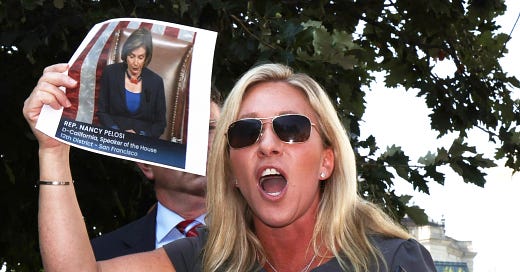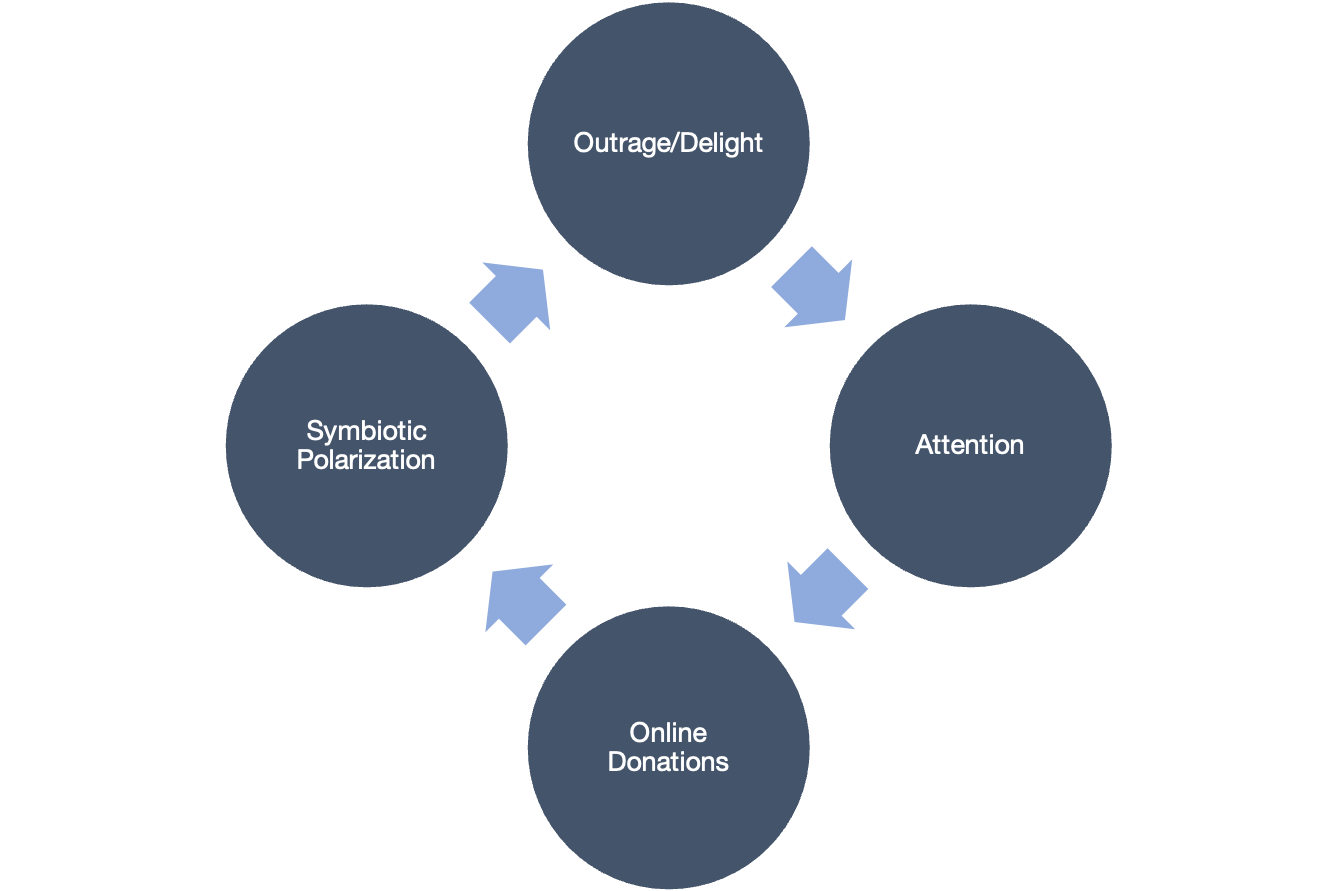Interrupting the Rage Cycle
Converting political outrage into profit is a big business that allocates our scarce resources without regard for what it takes to win. Let's stop rewarding “attention politicians” with clicks & cash.
The Democratic marketplace is bad at allocating resources. It is straightforward to quantify such inefficiency in dollars, but there’s an even scarcer resource that the marketplace does a bad job allocating: our attention.
As we’ve written before, there are several drivers of this inefficient marketplace:
The party lacks a centralized decision-making apparatus: there’s no CEO or board of directors for “The Democrats” that can step in and make informed, executable calls on how to best allocate limited resources.
There’s an insatiable appetite on the far-left for policies and slogans that make winning harder for Democrats and direct resources intra-party fights instead of beating Republicans.
And then there’s the supercharged 21st century challenge of attention scarcity.
In many ways, this dynamic is an inevitable byproduct of our modern reality. With an unlimited stream of information available to us 24 hours a day, 7 days a week, attention is scarce — and incredibly valuable to those who manage to get it. Academics even have a fancy term for it:
Attention economics forms the backbone of the advertising business model, as well as the approach of a new generation of political attention entrepreneurs. It makes a lot of sense: the less of our attention that’s available, the more it’s worth to those who want to sell us a product, convince us of an idea, or persuade us to vote for a candidate.
This scarcity produces misaligned incentives: in our hyperconnected, digital era, enterprising candidates who are able to capture our attention are rewarded without regard for how (or if) they contribute to winning elections.
From Donald Trump and Marjorie Taylor Greene to the Squad, the highest-profile newcomers on the political scene exhibit a keen understanding of the attention economy. They always seem to know what to say or do to keep their fans (and haters) outraged or delighted — and glued to their screens.
A vicious cycle emerges:
Outrage/Delight: A candidate says or does something that provokes an intense and polarizing response.
Attention: That candidate gets boatloads of news coverage and attention for whatever they said or did.
Online Donations: Hordes of ideologically-aligned online donors reward that candidate for being polarizing with a deluge of small dollar donations. Meanwhile, the candidate’s opponent(s) capitalizes on the outrage and hordes of ideologically-opposed donors reward that opponent with an equally sizable influx of contributions.
Symbiotic Polarization: With both candidate and opponent rewarded for their polarizing behavior, the cycle begins anew.
A multi-billion dollar ecosystem keeps the cycle spinning around the clock, with armies of digital fundraising consultants, influencers, etc. dipping in for their share of the spoils.
But at no point in the cycle do the hordes of donors pause to consider what their clicks and cash are contributing to. In fact, as the political scientist Eitan Hersh has noted, many online donors give money to candidates not for any strategic reason but simply because it feels good (read more about “Rage Donating” here). And so — in both parties — they send it, dollar after dollar, day after day.
Never Interrupt Your Enemy When They Are Making A Mistake
Politics in our two-party system is a zero-sum game. So a thought experiment exploring the counterfactual can help determine what actions are beneficial.
Do Democrats want the attention economy to shower a far-right Republican from Georgia’s deep red 14th congressional district clicks and cash? Yes.
Do Republicans want the attention economy to shower a far-left Democrat from New York’s deep blue 14th congressional district with clicks and cash? Absolutely.
Despite both districts being dominated by one party by a whopping margin of 30% or more, it’s not surprising that the representatives from NY-14 and GA-14 have both raised ~$9m this cycle with ~72% coming from small dollar donations. Because those districts are represented by AOC and MTG.
The inefficiency here is almost too obvious to warrant stating: AOC doesn’t need millions of dollars in a district where Nancy Pelosi famously noted that a “glass of water would win with a D next to its name” and neither does MTG in her Trump-loving enclave.
And the attention-driven resource allocation problem extends from the attention politicians to those running against them. In 2020, AOC’s Republican opponent made national news for raising more than $10 million (70% of it from small dollar donations) — and still got trounced 72% to 27%.
But Interrupt Your Teammates When They’re Making a Mistake
The same is now happening to MTG’s Democratic opponent, Marcus Flowers. Flowers is likely headed for a 30-point loss in November, but hordes of online donors either don’t seem to know or don’t care. Back in March, we wrote about how Democratic donors are getting bamboozled in The Bulwark:
“There is no Democratic pathway to victory in Greene’s district. Even for a high roller like Flowers. This fact has not stopped Democratic donors from giving Flowers more than $4.6 million in 2021 alone (87 percent via small-dollar donations of less than $200). That’s a haul exceeded by only a handful of other campaigns.”
Adding insult to injury, Flowers flourished while Democrats running in far more winnable districts were starved of critical resources:
“With redistricting now complete in all but a handful of states, WelcomePAC identified 21 newly-drawn districts where Trump won with 54 percent or less of the vote in 2020. These are seats that some Democrats, such as Rep. Jared Golden, have proven are winnable by appealing to center-right voters. In the majority of those districts—16 of 21—no Democratic challenger entered 2022 with more than $100,000 cash on hand. By contrast, Marcus Flowers kicked off the year with more than $1.5 million on hand.”
Unfortunately, the bamboozlement has only gotten worse since March: Flowers’ vast haul now eclipses $8.1 million, a figure that is likely to increase substantially as the general election campaign picks up steam. And while he entered Q2 2022 with more than $1.9 million in cash on hand, the top Democratic challengers running in the 15 of the 16 neglected districts we identified in March started the quarter with less than $90,000 in cash on hand.
Flowers is running a savvy campaign against a scorned attention politician. He’s able to raise gobs of money online with outrage bait like this:

Followed immediately by an ActBlue solicitation:


There’s no problem with running a successful, high-yield campaign like this in a winnable district, but at this point Marcus Flowers’ campaign is gobbling up important resources that could be headed to Democrats on the front lines this fall — both money and attention.
As WelcomePAC co-founder Lauren Harper put it in The Washington Post last month, “we can’t just focus our energy on the people who are driving us bananas.” Unbeatable attention politicians like Marjorie Taylor Greene might suck up our attention, but there’s no reason that their opponents such as Marcus Flowers should suck up our dollars with so many competitive races left to win.
Friends don’t let friends send their money to candidates running in unwinnable districts like Marcus Flowers.
It’s time to interrupt this cycle (at least on the side that is tasked with saving democracy) and redirect our precious attention and dollars to the districts we can actually win — districts like CA-41.




